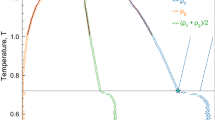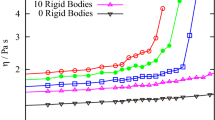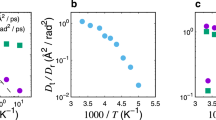Abstract
BY treating viscous flow, self-diffusion and dielectric relaxation as rate processes, it has been shown that in water the energies of activation associated with the foregoing processes not only exhibit the same temperature dependence but have identical values1,2. The dielectric relaxation time τ of a polar liquid has been expressed in terms of the viscosity η by the Debye equation:  where a is the molecular radius. Equation (1) does not hold for hydrogen-bond-associated liquids (such as 2-methyl heptan-3-ol and octan-1-ol)3, yet it holds for water, and the value of a = 1.4 Å obtained from a plot of τ−1 against η/T agrees well with recently published data4. The foregoing findings can be explained with the aid of the ‘flickering cluster’ model for water, described by Frank and Wen5, on the basis that the time taken for a translational jump or a molecular re-orientation is less than the mean life-time of the clusters, which may be of the order of 10−11 sec. Thus, in a discussion of viscous flow, the nature and concentration of non-hydrogen-bonded water must be considered a major factor. This is made possible by using the cluster model of Nemethy and Scheraga6. For ease in computation the clusters are taken to be spherical and, from a consideration of their total area and volume, the xi parameters (mole fractions of i-bonded water) are calculated as functions of temperature. The molar volume of water, , is the sum of the volume of clusters, Vb, and the volume of dipolar water, Vu and it is given by:
where a is the molecular radius. Equation (1) does not hold for hydrogen-bond-associated liquids (such as 2-methyl heptan-3-ol and octan-1-ol)3, yet it holds for water, and the value of a = 1.4 Å obtained from a plot of τ−1 against η/T agrees well with recently published data4. The foregoing findings can be explained with the aid of the ‘flickering cluster’ model for water, described by Frank and Wen5, on the basis that the time taken for a translational jump or a molecular re-orientation is less than the mean life-time of the clusters, which may be of the order of 10−11 sec. Thus, in a discussion of viscous flow, the nature and concentration of non-hydrogen-bonded water must be considered a major factor. This is made possible by using the cluster model of Nemethy and Scheraga6. For ease in computation the clusters are taken to be spherical and, from a consideration of their total area and volume, the xi parameters (mole fractions of i-bonded water) are calculated as functions of temperature. The molar volume of water, , is the sum of the volume of clusters, Vb, and the volume of dipolar water, Vu and it is given by:  (In this representation of the molar volume of water lies one of the main differences between this model and that proposed by Frank and Quist, in whose gas hydrate type structures unbonded water molecules can only fill vacant sites in the clusters and therefore cannot contribute to (ref. 10).) where Vb can be taken to be the extrapolated molar volume of ice, and Vu can be calculated at each temperature from a knowledge of xi, and Vb
(In this representation of the molar volume of water lies one of the main differences between this model and that proposed by Frank and Quist, in whose gas hydrate type structures unbonded water molecules can only fill vacant sites in the clusters and therefore cannot contribute to (ref. 10).) where Vb can be taken to be the extrapolated molar volume of ice, and Vu can be calculated at each temperature from a knowledge of xi, and Vb
This is a preview of subscription content, access via your institution
Access options
Subscribe to this journal
Receive 51 print issues and online access
$199.00 per year
only $3.90 per issue
Buy this article
- Purchase on Springer Link
- Instant access to full article PDF
Prices may be subject to local taxes which are calculated during checkout
Similar content being viewed by others
References
Wang, J. H., J. Amer. Chem. Soc., 75, 466 (1953).
Haggis, G. H., Hasted, J. B., and Buchanan, T. J., J. Chem. Phys., 20, 1452 (1952).
Connor, W. P., and Smyth, C. P., J. Amer. Chem. Soc., 65, 382 (1942).
Orttung, W. H., J. Phys. Chem., 67, 503 (1963).
Frank, H. S., and Wen, W. Y., Disc. Faraday Soc., 24, 2002 (1954).
Nemethy, G., and Scheraga, H. S., J. Chem. Phys., 36, 3382 (1962).
Saito, N., J. Phys. Soc., Japan, 5, 4 (1950).
Vand, V., J. Phys. Colloid Chem., 52, 277, 300, 314 (1948).
Wada, G., Bull. Chem. Soc. Japan, 34, 955 (1961).
Frank, H. S., and Quist, A. S., J. Chem. Phys., 34, 604 (1961).
Feates, F. S., and Ives, D. J. G., J. Chem. Soc., 2798 (1956).
Franks, F., Gent, M., and Johnson, H. H., J. Chem. Soc., 2716 (1963).
Author information
Authors and Affiliations
Rights and permissions
About this article
Cite this article
FRANKS, F., GOOD, W. Mechanism of Viscous Flow in Water. Nature 210, 85–86 (1966). https://doi.org/10.1038/210085a0
Issue Date:
DOI: https://doi.org/10.1038/210085a0
This article is cited by
-
Membrane osmometry of aqueous micellar systems
Kolloid-Zeitschrift und Zeitschrift für Polymere (1972)
Comments
By submitting a comment you agree to abide by our Terms and Community Guidelines. If you find something abusive or that does not comply with our terms or guidelines please flag it as inappropriate.



